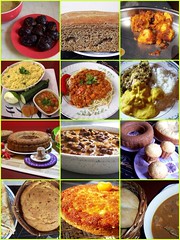 I made two soups and a salad for lunch on Janmashtami after a heavy festive breakfast. One of the soups was this creamy Spinach soup and the other one was this delicious tomato carrot soup. The salad was my usual roasted salad with lots of mixed vegetables.
I made two soups and a salad for lunch on Janmashtami after a heavy festive breakfast. One of the soups was this creamy Spinach soup and the other one was this delicious tomato carrot soup. The salad was my usual roasted salad with lots of mixed vegetables.Shredded carrots and peeled tomatoes, cooked along with some herbs and spices and then pureed for a quick, tasty bowl of warm goodness! You can add a small grated potato to this for some thickness. This time though, I went with a small piece of pumpkin - it not only adds texture but also a beautiful orange colour.
Tomato Carrot Soup
3-4 tomatoes, blanched and peeled
(immerse the tomatoes in boiling water for 5 minutes, remove and plunge into cold water. Peel)
2 carrots, peeled and grated
1 onion finely chopped
1 clove garlic minced
1 bay leaf
small piece of pumpkin, peeled and roughly chopped
1/4 tsp red chilli powder
1/2 tsp cumin powder
salt and pepper powder to taste
a sprinkle of mixed dried herbs
oil - 1 tsp
1. Chop the peeled tomatoes. Heat the oil in a heavy bottomed pan, add the bay leaf and garlic.
2. Toss in the chopped onions and saute for 5 minutes till transluscent.
3. Add the grated carrots, chopped pumpkin and tomatoes and saute for about 3-4 minutes.
4. Add the chilli powder, salt and cumin powder and after a minute, add 3-4 cups of water and bring to boil.
5. Reduce flame and simmer covered for about 10-15 minutes till the vegetables are cooked.
6. Cool, remove the bay leaf and puree the mixture. Add a little water if needed and return to the fire. Adjust salt and pepper, put in the mixed herbs and pepper and remove from flame.
7. Serve warm with a crusty bread.










